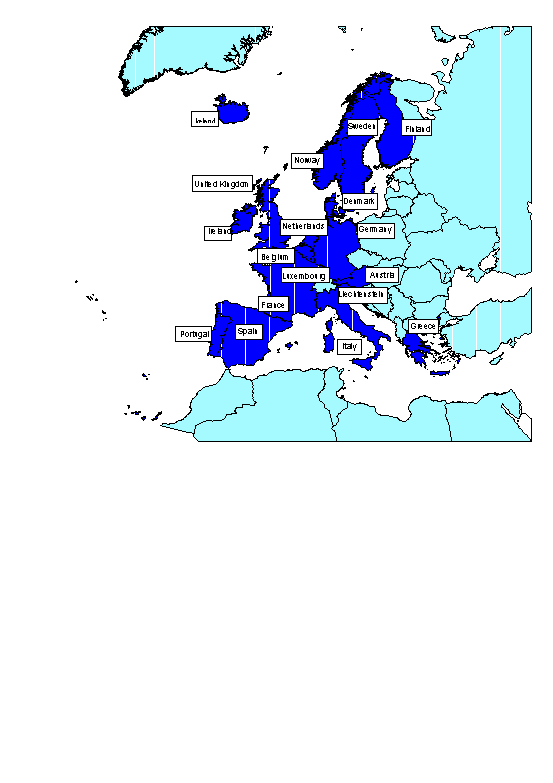Executive Summary
The United Nations Convention on
Biological Diversity (CBD) was signed at Rio de Janeiro in 1992 by 157 Parties or States,
including the European Community and all 18 Member Countries of the European Environment
Agency (EEA). In 1996 the EEA let a contract to ITE to assess progress in its Member
Countries towards implementation of the Convention at the national level. A questionnaire
survey was sent to official national focal points for the CBD: 16 replies were received
and analysed; a Workshop was held for delegates from official bodies, scientific
institutes and the EEA to discuss the responses and consider a number of relevant issues
of common concern to all Member Countries.
The survey showed that ten countries had
established a national biodiversity coordinating body; all had either developed a national
strategy in response to the Convention or were in the process of doing so; three had
published a biodiversity action plan, four were preparing one and seven intended to do so
in the near future. All countries had integrated, or intended to integrate, conservation
and sustainable use of biodiversity into relevant sectoral or cross sectoral plans.
14 countries reported that they had
identified relevant components of biodiversity in relation to conservation and sustainable
use, and 16 had monitoring programmes in place or planned to evaluate the effects of
adverse impacts. In most cases, these impacts had not been compared with the overall
status and trends in biodiversity. All countries had implemented plans or used existing
legislation to satisfy requirements for in-situ conservation; the EU Habitats and
Birds Directives were frequently cited.
The main challenge for signatories to the
Convention is to turn plans into effective action, and the survey showed that many Member
Countries appeared to have problems in achieving this, thus slowing down the process.
Examples of good practice which have been demonstrated in a few countries should act as
guidance for others. A key question is whether the Convention has actually changed
policies and actions at the national level, or would these have happened without the
Convention? The survey at this early stage of implementation of the CBD could not answer
this question.
Successful implementation of the Convention
requires: cooperation and coordination both at different levels within a country and
internationally; gathering suitable knowledge on biodiversity and disseminating it through
education and information programmes; establishing a political, ethical, moral and
financial commitment; adoption of suitable legislation and enforcement measures; setting
targets and indicators.
| Box 1: Biodiversity Biodiversity is the whole variety of life-forms on
Earth, ranging from mammals, birds, reptiles, amphibians, fish, insects and other
invertebrates, to plants, fungi, algae and micro-organisms. Scientists have tried to
estimate the number of species and agree that the majority have not yet been described:
they may number between 5 and 30 million. However the concept of biodiversity goes beyond
the multiplicity of species, and includes the variability of genes and of forms within a
species, and the assemblages of plants, animals and micro-organisms which together
constitute ecosystems and natural habitats. The Convention on Biological Diversity defines
biodiversity as:
The variability among living
organisms from all sources including, inter alia, terrestrial, marine and other
aquatic ecosystems and the ecological complexes of which they are part; this includes
diversity within species, between species and of ecosystems.
This definition therefore includes three
levels of biodiversity: (a) diversity between and within ecosystems and habitats; (b)
diversity of species; and (c) genetic variation within individual species. The linkage
between species and their habitats is vital: changing a habitat will usually affect the
diversity of species contained within it, while conversely a change in species number and
composition may well affect the nature of the habitat. A crucial indicator of the
"health" of a local environment is obtained from its wildlife community. If the
rate of change (particularly, of loss) is markedly greater than long-term evolutionary
processes would imply, this could indicate a systematic problem to which serious attention
should be paid. UNEP(1) has estimated that species extinction has been 50 to
100 times the natural rate for the past four centuries, and that this is expected to rise
to 1000 to 10000 times the natural rate.
Agenda 21, adopted at the Earth Summit in
Rio de Janeiro in 1992, states the importance of biological diversity to mankind as
follows:
Our planets essential goods
and services depend on the variety and variability of genes, species, populations and
ecosystems. Biological resources feed and clothe us and provide housing, medicines and
spiritual nourishment. The natural ecosystems of forests, savannahs, pastures and
rangelands, deserts, tundras, rivers, lakes and seas contain most of the Earths
biodiversity. Farmers fields and gardens are also of great importance, while gene
banks, botanical gardens, zoos and other germplasm repositories make a small but
significant contribution. The current decline in biodiversity is largely the result of
human activity and represents a serious threat to human development.
|
Figure 1: EEA Member Countries


1 UNEP(1995), Global Biodiversity Assessment


Document Actions
Share with others